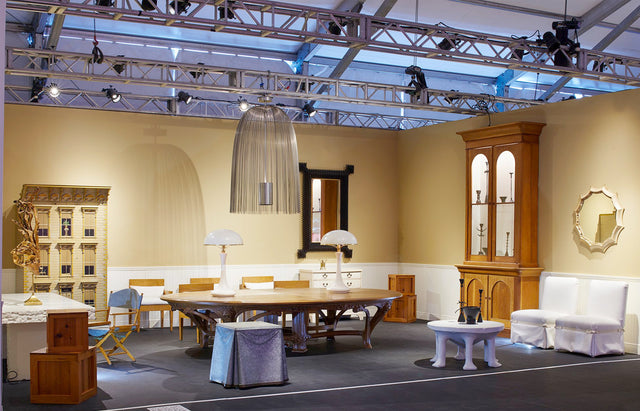Design Miami/ The Firehouse
In 1963, when John Dickinson purchased and renovated a dilapidated municipal firehouse building on Washington Street in Pacific Heights, he created one of the most enigmatic and important interiors in 20th C. America.
Building on the myth of the 1906 Earthquake, the primal origin story of modern San Francisco, Dickinson turned the region’s existing historicist and Victorian design aesthetic on its head and created a cultural power site. His avant-garde solutions to the region’s unstable material culture would extend to Wine Country, as elites consolidated their identities by building out Sonoma and Napa.
CONVERSO is pleased to present, The Firehouse, a recreation of John Dickinson’s extraordinary San Francisco interior. Important elements original to The Firehouse will be presented. These include: Dickinson’s hand painted trompe-l’oeil dressing cabinet styled as an earthquake damaged Painted Lady; a monumental Tramp Art Mirror; a Galvanized Metal Table with tin drapery; the original low large round wooden version of the famous Africa Table A large and beautiful Willow Chandelier by Harry Bertoia will hang in compliment, along with Dickinson’s illusionistic faux stone table/desk from 1975.
Anchoring the presentation, CONVERSO has recently rediscovered Dickinson’s massive art nouveau oak table attributed to Victor Horta, which Dickinson used as his desk and for dining, the focal point of The Firehouse interior. A center piece of Baron Auguste D’Anethan’s Belgian Embassy in Paris in 1900, the year the Belgians completed the Paris Metro with its famous entrances by Hector Guimard, the table was part of an ensemble of works produced for the Embassy intended as cultural politics at its most refined: It was created at the apex of Belgian Art Nouveau in the year of the Exposition Universelle de Paris, which drew over 40 million visitors. The table is a fragment from the universe of Proust and the Guermantes, Proust’s Belgian/ French aristocratic characters, all based on major personalities of the Belle Époque. D’Anethon himself modeled the Belgian Ambassador Proust described as drawn to his famous character, Odette.

One imagines Dickinson self consciously channeling Baron de Charlus, Proust’s ultimate dandy, moving amongst the elites of Pacific Heights while swimming in the sexual countercultures of San Francisco in the psychedelic era of The Fillmore. Bohemian and Berkeley born, he pursued an avant-garde solution tending toward the surreal, framed by a formalism imbibed at Parsons, one side of a dynamic tension with Northern California’s famous informality: a High/Low aesthetic, Levi jeans and all, buttoned canvas flaps for window treatments. Dickinson’s zoomorphic/ anthropomorphic expressions are wild and weird and self consciously primitive.
After Dickinson’s death, The Firehouse would continue to house the powerful as ownership passed through a succession of important figures. Jerry Brown eventually launched his 1992 presidential bid from the Firehouse. Once again, the cultural wed to the political.

